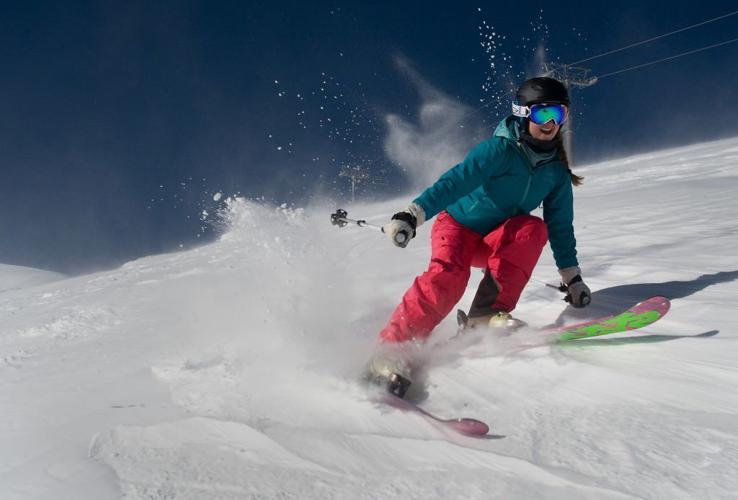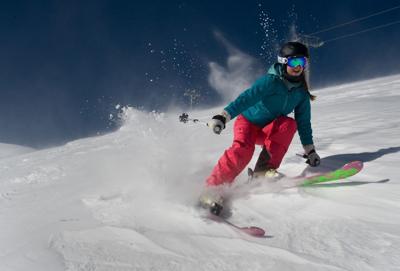BRECKENRIDGE SKI RESORT – Holley Adcock, 64, has been skiing, on and off for 40 years.
But get her off the groomers onto a black diamond run and anxiety strikes. She’s a Breckenridge local, but that doesn’t mean she’s confident tackling every run on the mountain. Skiing, she said, “is easy to learn and very hard to master.”
Adcock is not alone in her wariness.
“With the black (runs), I am very afraid of them,” said Jimena Ferraez, on vacation from Spain. “I’m very afraid to break a leg or something.”
The women were taking an intermediate/advanced skiing workshop last week with the Breckenridge Ski and Ride School, rated 7 on the scale of 1-9 in skiing ability. Among the various milestones of a skiing career, graduating from the blues to the blacks is the toughest, and one that holds back many skiers for years, if not their whole lives.
That’s why I tagged along with this class, to see how experts help skiers reach this next level, to learn to love the steeps and bumps, the trees and chutes and, of course, that sweet Colorado powder.
I discovered it’s largely a mental game, with skiers needing to build confidence as much as the minor technical tweaks it takes to ski black diamonds.
In fact, if you ski green and blue runs, you already know it.
“The physical skills at upper levels are the same skills as when you learned to ski,” said ski-school supervisor Bill O’Brien. “It’s just different applications.”
We’re not talking about kids. Shortly after learning to ski, they’re often bombing down double-diamond pitches without a second thought.
It’s skiers who learned as adults who often can’t shake the blues.

Victor Ferraez contemplates his first black diamond run during a lesson at Breckenridge Ski Resort.
“They got to a plateau. They get frustrated with their skiing and they’re not really sure what’s going on,” said Breckenridge instructor Joe Linus. “People get to a certain level and they don’t have confidence in their abilities to ski the steeps. They’re OK on groomed terrain, but once they get onto un-groomed, that’s when they start losing a lot of their form.”
Maintaining one’s skiing form was the focus of our class. We began on comfortable groomers, practicing the skiing stance — knees bent, shoulders squared — and then making sharp turns, sometimes known as “hockey stops,” on the corduroy snow. Let the lower body make the turn. Roll the ankles. Plant a pole on the inside of the turn, using it as a pivot point as you swing your skis along the snow, without lifting them off the ground.
“Hands over the feet, shoulders over the hips,” said our instructor, Mike Powell. The voice of my long-ago beginning teacher echoed in my head.
We warmed up to making precise turns on a closed slalom course, then we hit the moguls.
Moguls and trees make the perfect training ground for tougher terrain. Both require precise turns, in snow from powder to ice. And the only way to learn is to practice, and then practice some more.
“A lot of people try to find a magic solution for skiing the bumps. It’s more about trying to blend skills,” said Powell.
Once you learn to survive moguls, the next step is to survive them well, focusing on slowing your movements, being patient with each turn. This patience is one of the hardest things for the aspiring black-diamond skier to learn. When gravity is pushing you down a steep slope, you tend to make too many short zigzags, rather than organically finessing the fall line.
From the moguls we moved to some of the easier black diamond runs off the T-Bar lift, which offered many of these advanced students the steepest un-groomed terrain they had skied.

Kara Shay navigates a chute on the double black Prima Cornice run at Vail. Courtesy of The Associated Press.
By late afternoon, Victor and Jimena Ferraez were fluidly negotiating the bumps on some of Breckenridge’s easier black diamond runs. Not every turn was straight from the “learning to ski” manual, but they’re not supposed to be.
Said Powell, “Fifty percent of the time you do it right. Fifty percent of the time, you just do it.”
Since fear, as much as skill, holds skiers back from tougher terrain, the key is having the right foundation. An instructor can ensure your form is right while you’re tackling the unknown.
“Almost always it’s confidence,” Powell said. “If we jump into the (tougher) terrain without some of the basic skills that are needed, the confidence could go down.”
The goal, said several instructors, is reaching that “ah-ha” moment, when your skill set kicks in and your confidence is boosted. Then, said Powell, “the whole mountain kind of opens up differently to people.”
Adcock, the longtime skier, felt that moment during our workshop. “Being patient on the downhill, it was a really big breakthrough,” she said.
Is she ready to conquer black diamond runs on her own?
“I’m not there yet, but I’m getting there.”
MAKE BLACK DIAMONDS YOUR BEST FRIENDS
In moguls
In trees
In powder

Instructor’s advice
AT EVERY LEVEL, skiing is easy when you are in balance. When you aren’t, every move you make is an effort to get balance back. If you somehow manage to turn or stop, it will be a byproduct of trying to regain balance. Being out of balance is quite tiring, as well. So stand up and find your balance!
FOR LESS EXPERIENCED skiers, the fastest way to lose balance is to let feet get ahead of hips. When you stand with your hips directly above the middle of your feet, you’re balanced. However, your feet are in boots bound to skis that are sliding. So if you bend at the hips, like sitting, your feet get ahead of your hips, and you lose balance. Better to stand upright, with hip sockets, shoulders and ears stacked in a line directly above the arches of your feet.
IN BOOTS AND WITHOUT SKIS, focus eyes on a point directly ahead of you and reach hands forward, like holding handlebars. Now lightly hop by using your legs and ankles, and land in balance. The boots allow you to flex ankles by bending boots forward with shins, then you hop by straightening ankles. When you are balanced during boot-hopping, try it with skis on, while sliding straight along a very gentle slope. Looking and reaching ahead, and slightly tensing your core muscles, will keep you balanced, with hips over feet. —Mark Scofield, Colorado Springs, 31-year ski instructor










(0) comments
Welcome to the discussion.
Log In
Keep it Clean. Please avoid obscene, vulgar, lewd, racist or sexually-oriented language.
PLEASE TURN OFF YOUR CAPS LOCK.
Don't Threaten. Threats of harming another person will not be tolerated.
Be Truthful. Don't knowingly lie about anyone or anything.
Be Nice. No racism, sexism or any sort of -ism that is degrading to another person.
Be Proactive. Use the 'Report' link on each comment to let us know of abusive posts.
Share with Us. We'd love to hear eyewitness accounts, the history behind an article.